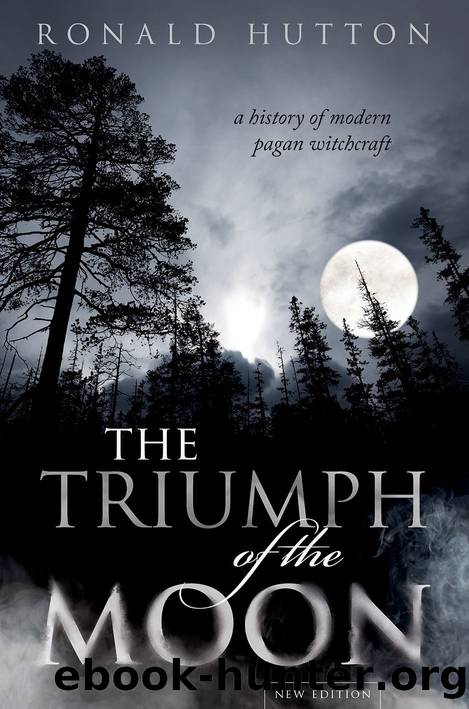The Triumph of the Moon: A History of Modern Pagan Witchcraft by Ronald Hutton

Author:Ronald Hutton [Hutton, Ronald]
Language: eng
Format: epub
Tags: 20th Century, Body; Mind & Spirit, History, Non-Fiction, Paganism & Neo-Paganism, Religion, Witchcraft
ISBN: 9780192562296
Google: 6ZOzDwAAQBAJ
Publisher: Oxford University Press
Published: 2019-10-09T23:00:00+00:00
[281]
14
The Wider Context
Reinforcement
The previous chapter emphasized those factors in mid-twentieth century British society which would tend to encourage a hostile response to modern pagan witchcraft. The most important single argument of this book, however, is that this witchcraft was the result of a particular combination of major cultural trends which had developed in that society since 1800; and that during the twentieth century most of these trends were still in force. It is necessary, therefore, to look now at aspects of mid-twentieth-century Britain which tended to reinforce the self-image of pagan witchcraft, and to encourage an acceptance of it among non-initiates.
The simplest and most easily documented was the continued activity of figures who had contributed towards that self-image. One was Robert Graves, who communicated his idea that the entire ancient world had worshipped the Triple Moon Goddess to a much wider public with his two-volume retelling of The Greek Myths, published in 1955. It has been mentioned that Gardner visited him in 1961. Graves may already have published by that time a short story entitled âAn Appointment for Candlemasâ, which was a good-humoured and sympathetic portrait of a Wiccan coven in contemporary North London, based either upon Gardnerâs writings, or the press reports, or both; if it dates from after the visit, then it was a direct literary product. He subsequently produced an essay on Wicca, which swallowed whole Gardnerâs account of his discovery and revival of it. The piece incorporated further information upon contemporary witches, probably furnished by another of them, a character known as âTaliesinâ who will be discussed later.1
Margaret Murray also remained active throughout the 1950s. In 1954 she produced her third book on her putative medieval witch religion, The Divine King in England, which suggested that every violent royal death and almost every execution of a failed politician in England between 1066 and 1600 had in fact been a human sacrifice, representing Frazerâs dying and returning god, under the laws of the Old Religion. It was her most imaginative and least plausible work, and won no acceptance in the world of professional scholarship; but it was presumably believed by at least some of the general public. In 1963 she brought out The Genesis of Religion, a personal view of ancient spirituality in which she whole-heartedly endorsed the [282]idea that the prehistoric European and Mediterranean world had worshipped a single supreme female deity.
At the same time, her original thesis about the nature of medieval and early modern witchcraft was continuing to gain adherents. This was due in part to her own promotion of it in the popular press, especially Sunday newspapers and magazines, where she was treated throughout the 1950s as the leading expert on the subject. In 1963 the American-based academic expert, Rossell (sometimes given as Russell) Hope Robbins, gave a series of lectures in Britain in which he restated the traditional view that witchcraft as such had never existed, and that the victims of the early modern trials had been victims of delusion, malice, and superstition.
Download
This site does not store any files on its server. We only index and link to content provided by other sites. Please contact the content providers to delete copyright contents if any and email us, we'll remove relevant links or contents immediately.
| Buddhism | Christianity |
| Ethnic & Tribal | General |
| Hinduism | Islam |
| Judaism | New Age, Mythology & Occult |
| Religion, Politics & State |
Cecilia; Or, Memoirs of an Heiress — Volume 1 by Fanny Burney(31355)
Cecilia; Or, Memoirs of an Heiress — Volume 3 by Fanny Burney(30952)
Cecilia; Or, Memoirs of an Heiress — Volume 2 by Fanny Burney(30909)
The Secret History by Donna Tartt(16677)
Sapiens: A Brief History of Humankind by Yuval Noah Harari(13086)
Leonardo da Vinci by Walter Isaacson(11927)
The Radium Girls by Kate Moore(10924)
Sapiens by Yuval Noah Harari(4560)
The Wind in My Hair by Masih Alinejad(4430)
How Democracies Die by Steven Levitsky & Daniel Ziblatt(4427)
Homo Deus: A Brief History of Tomorrow by Yuval Noah Harari(4294)
Endurance: Shackleton's Incredible Voyage by Alfred Lansing(3857)
The Silk Roads by Peter Frankopan(3794)
Man's Search for Meaning by Viktor Frankl(3657)
Millionaire: The Philanderer, Gambler, and Duelist Who Invented Modern Finance by Janet Gleeson(3577)
The Rape of Nanking by Iris Chang(3530)
Hitler in Los Angeles by Steven J. Ross(3450)
The Motorcycle Diaries by Ernesto Che Guevara(3348)
Joan of Arc by Mary Gordon(3272)
